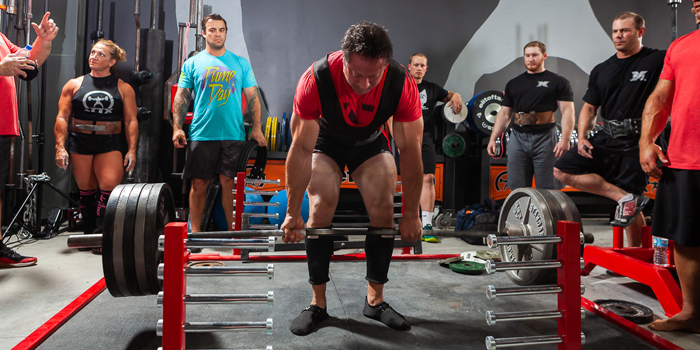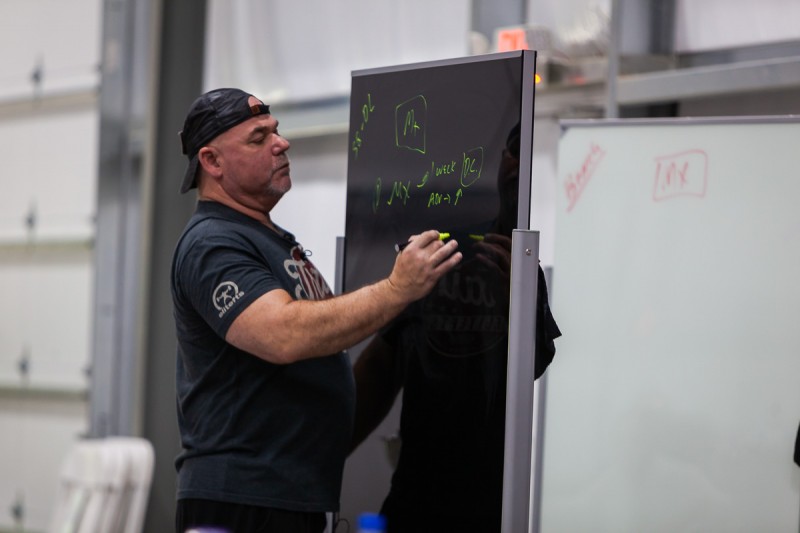
Coaching both powerlifting and weightlifting, one of the first things that I try to instill in lifters is the importance of a training journal to record all of their training cycles.
In the past, I had told lifters to write down their goals for their lifts on the first page and track their training lifts on subsequent pages. I left it and referred back to the log when we discussed prep for a competition. However, this training log was one-dimensional. It just gave us weights and was often incomplete. Lifters would forget to record entire sessions or weeks because the training journal didn’t feel like an important part of their ultimate success. It became "something that you're supposed to do" because the coach said to, and his coach said he should do, ad infinitum.
A popular term now is “mindful." This is the practice of being engaged in the task that you are doing. If you are reading a book, that’s all that is in your head; if you are squatting, you are thinking about your setup, bracing hard, and standing fast; if you are breathing, you are focused entirely on the breath.
RELATED: A Holistic View of Autoregulation
Being mindful and deliberate in your training directly improves performance. The increased focus on the task equates to more effort, weights moving faster, better technique, and more progress. There are many drills and techniques to help improve mindfulness, but for the lifter, we need to rethink the training journal and its importance as it relates to mindfulness. Here are three places to start to make your training journal more useful and ultimately a major tool in your success as an athlete.
Set Multiple Types of Goals
A goal that several lifters have is to win Nationals. Winning Nationals is an outcome goal. It depends upon your performance against others.
Maybe your goal is hitting a 300kg total. Every lifter at some point puts numbers in their mind that they want to hit— weights that have meaning to them whether it's a total or a specific lift (ex. 500-pound deadlift, 315-pound bench, etc.). These are performance goals and are all about our performance compared to ourselves and not others.

Another type of goal that isn’t often set is a process goal. These are goals that focus less on what you do but more on how you do it. When you are working towards that 500-pound deadlift, you want to make sure that you don’t just make the lift, but you make it with good technique. A process goal for you could be to brace during your setup. Maybe you let the bar get away from you, so now you work on engaging your lats to keep it close. These would be process goals you would write down before your training session to have direction on what you should focus on that day to get better. By the end of the session, you might have hit a weight you have hit before, but maybe it moved easier because you focused on the process.
All types of goals are useful to set. We have the dream (an outcome goal), the thing we are working towards gradually (performance goal), and then a focus on what we are trying to accomplish (performance and process). Each of the goals contributes to your motivation as you achieve something every day. This will create a more productive training environment that will keep you more engaged in your training sessions.
Track Rating of Perceived Exertion (RPE)
RPE is a method of rating the work that you do following a bout of work. Exertion is rated on a 1-10 scale, with 1 as low and 10 as high. Training should always have a high degree of effort as well, but effort needs to be separated from exertion. So, some quick definitions:
Effort is the focus or attention that you put towards the process you are trying to accomplish.
Exertion is how much work you put into an exercise. Essentially, how taxing something is on your body and how much fatigue it generates. This is what we are trying to rate with RPE.
Below are definitions of RPE as it pertains to strength work and the competition lifts for weightlifting. In some cases, I reference “reps in reserve.” This means, for example, that after performing five repetitions of the back squat, you can still do X number of reps. If you did five reps, and could still feel as though you could do three more (and that would be an all-out effort), you would rate that an RPE 7.
RPE for Strength Work
RPE<5: Warm-up work. It is hard to distinguish how many reps you could do.
RPE 5: Feels like weight beyond a warm-up set. Approximately five reps in reserve.
RPE 6: Appropriate weight for a light day or session. Enough weight that you need to focus but you could do more easily. Approximately four reps in reserve.
RPE 7: No psych up necessary but, attention and focus are high. The weight feels smooth with good speed and technique. Approximately three reps in reserve.
RPE 8: Low to moderate psych up. Attention and focus are very high. Approxmately two reps in reserve with this mentality. It's a working weight that if you went up, you would be straining and needing to mentally prep yourself for.
RPE 9: Moderate to high psych up. Leave some mentally and physically leftover but always focus on the work.
RPE 10: All you got but, don't kill yourself or risk injury. No reps left in reserve.
RPE for Snatch and Clean and Jerk (and variations)
RPE ≤5: Warm-up work. You can perform reps with minimal exertion.
RPE 6: You can perform three to five reps with the weight with confidence and not miss.
RPE 7: You can perform two to three repetitions with the weight with confidence and not miss. You should finish your set feeling like you could do more weight but that you were challenged.
RPE 8: A challenging weight that you can perform one (maybe two) repetition. You won’t miss but, you need to exert yourself a bit to perform correctly. You should feel you could add more weight but then that would increase the chances of missing. Consider this a conservative opener in a competition.
RPE 9: A challenging weight that you could only hit for 1 repetition. You must be focused and psyched up for this. There is a greater probability of success than failure (20% chance of failure). You would take a conservative jump (2-4kg) after this if you did at all. This would be a risky opener but a good second attempt.
RPE 10: Your best, a weight that is within your capability but has a higher degree of failure.
Tracking how something feels from an exertion or fatigue inducing standpoint can help you separate the days when one day you deadlift 400 pounds at RPE 9 and another day you hit 400 pounds at RPE 7. They were both singles in the training log but one moved significantly faster and easier than the other one. That is progress and should show. Nothing can be more defeating than not seeing the weight on the bar move up but this gives you another perspective. Not only that, tracking RPE requires you to have your training journal with you during your session so you have to reflect and think about the lift you just took. You aren’t looking at video or asking your coach something. Instead, you are internally focused and considering your relationship with what you just did. This can in turn help to build confidence, solve problems, establish greater motivation, and ultimately make you a more resilient and determined athlete.
Journal Following Your Sessions
You have goals before your session, you have your workout, but what happens after the session is over. How do you feel about the entirety of your training session? What stood out about today's training session? What do you need to improve on? What did you do well?
These are all questions that you can and should ask yourself following your training. When you reflect on your training session, beyond the weight or repetitions, you will find the mindset that you approached the training session with. You will see if you were just going through the motions or focused on what you were doing. It is also a chance to consider what you can improve upon without berating yourself. Give yourself constructive feedback as a friend that will inform your process goals in future sessions. Give yourself praise for things that you are proud of. We worry about coaches or other teammates chastising us but we tend to be our own worst critics. It's easy to find faults, but we seldom tell ourselves "good job." This is why that last question is equally as important. It tells you that you are in the right direction with training to build a positive self-image that will translate to greater confidence on the platform.
This type of reflection on your training feeds back into the other points of goal-setting and tracking RPE as well because reflection is an important part of mindfulness in your training. It allows us to repeat successes and improve faults so that we can plan for the future.
These are just some of the ways you can make the training journal a useful tool to help achieve greater success as a lifter. A journal is what you make of it and personal to the athlete. It is used to reflect, stay engaged in our training session and showcase our progression from where we were, to where we are, and where we wish to be.
Erik is a professor of anatomy and physiology for Cal State University San Marcos (NCAA- D2) and formerly their sports performance coach for athletics. He is also a National coach and certification instructor for USA Weightlifting and a National-level strength athlete across multiple strength disciplines. As a coach of strength sports, he has produced National level lifters in both weightlifting and powerlifting across multiple age categories. As a sports performance coach, he has worked with athletes from youth, high school, college, Olympic, and professional levels. Check out his website: Squatmore.











And for sports where technique is an important part, I want all clients to video their lifts, especially for those involved in Olympic lifting. And, I tell them to study the video's, especially of missed lifting. Doesn't do any good to just look at them. They need to be studied so any form breaks can be corrected, nd if the coach is remote, so he can see the athlete's progress.
Pretty much all of the above holds true for written journals; they need to be studied, used as a training tool.